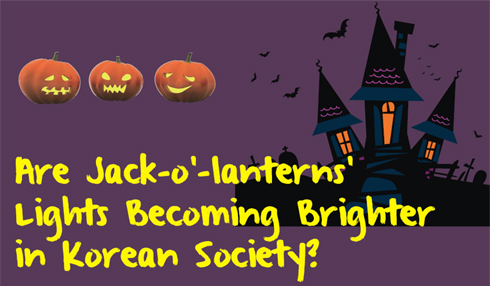
Nowadays in Korea, Halloween is no longer a holiday that only children can enjoy. Various clubs and bars hold parties to celebrate Halloween and some theme parks are decorated with a Halloween theme. Some celebrities upload photos to Social Network Services of themselves getting dressed up, wearing terrifying or provocative Halloween costumes, to stimulate the interest of their fans.
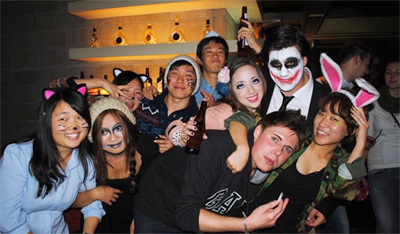
Halloween in Korea
Then, how deep is Halloween culture taking root within Korea? We checked on how Halloween festivals are progressing in English institutes, which played a leading role in spreading Halloween into Korean society. We interviewed Heidi Leigh Ferster, who works as a teacher in an English institutes near Mokdong.
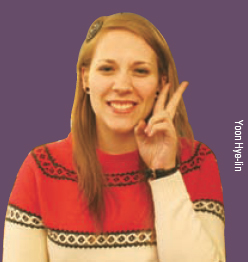
How do people celebrate Halloween, if they are not children, but rather adults? This past Halloween, SeoulMate, an organization that helps exchange students adapt to life at the University of Seoul (UOS), held a Halloween party on UOS’s campus. We interviewed Kim Hyun-soo (Dept. of Business Administration, 10’) of SeoulMate who helped plan the Halloween party.
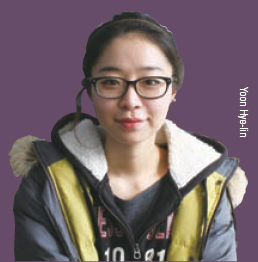
Surveys about Halloween
How do UOS students appreciate Halloween? We conducted a survey of 121 students.
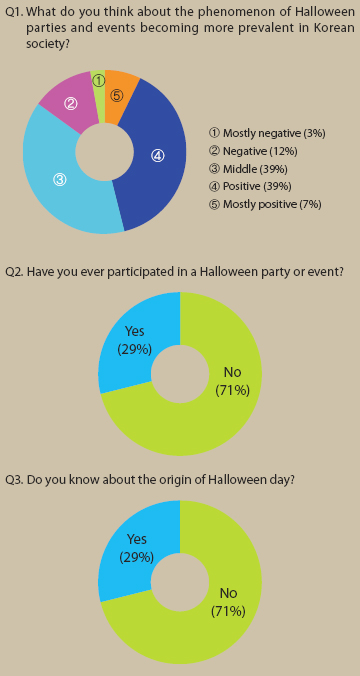
On the other hand, negative responses only counted for 15% of those surveyed. These respondents sneered at people who celebrated a western holiday without knowing about Korean holidays well, and said just enjoying something without knowing its purpose or origin is wrong. There were other opinions such as ‘Halloween does not fit in with Korean’s sentiments,’ ‘It seems to degenerate into just a day of wearing costumes,’ ‘People spend too much money’ and so on.
39% of respondents took a neutral position. They had several ideas. For example, enjoying a party is a matter of personal choice; it is just a holiday like Christmas or Saint Valentine’s Day, and Halloween is not as prevalent as people might think. However, the opinion that individuals do not care much about Halloween culture was overwhelming. It seems that such indifference is related to the proportion of people who have participated in Halloween parties in the past, which was only 29%.
The ratio of people who know about the origin of Halloween was 29%. There was a gap of more than 10% between 29% and the above mentioned 46%. Of course, knowing about the origin of Halloween itself would not be absolutely related to the attitude of acceptance. However, to some extent this result shows the fact that many people think they can fully enjoy that culture, regardless of whether they know about its origin or not.
Then, in the west where modern Halloween culture started, how much do they know about Halloween? Heidi responded that “Many Americans do not know the origins of Halloween. I think I know a little, but I do not know everything about it. People just have fun by doing activities like decorating a tree or buying presents for their family on Christmas. During Halloween, people can dress up how they like and pretend to be someone else.”
What does she think about Koreans enjoying Halloween without knowing about its origin? “It is interesting that Korean people celebrate Halloween, because it is from a different culture. Even though I am a foreigner, I celebrate Chuseok. It is because I know what it is. However, if I did not know about Chuseok, I would not celebrate it. If it bothers them that they do not know much about it, then they should look it up online. But I do not think most people care about where it came from. Nevertheless, I think celebrating Halloween in Korean society is good because it exposes Koreans to other cultures.”
A Survey about the Perception of Korean Feasts
It is rather unfortunate that most Americans also have fun at Halloween without knowing about the origin or meaning of it. However, at the same time, it is an interesting fact. How about Korean holidays, then? How much do UOS students know about these Korean holidays? We asked a question regarding the exact names and dates of Korea’s four major holidays. They answered as follows.
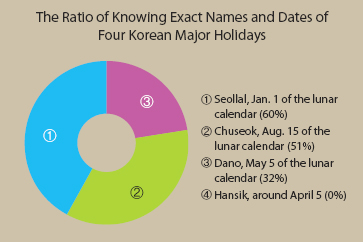
Conclusion
People no longer say that Christmas and Saint Valentine’s Day are only western holidays. Will Halloween be the same? It is not simply a question of Halloween. Foreign cultures are accepted so that we can experience a variety of cultures. Some of these cultures are taking root in Korean society. Many people are letting ‘enjoyment’ be the priority and do not take the time to deeply consider the origin or meaning of cultures.
The bigger problem is that while we accept other cultures joyfully, our culture is being neglected. It is the same for western cultures. While their cultures are being spread all around the world, the ‘essence’ of their cultures is being forgotten and is disappearing replaced by ‘entertainment’ and ‘light enjoyment.’
It is important that we pursue happiness during our lifetime. However, we should at least know about the fundamentals of our sources of enjoyment. A culture where people do not know its fundamentals will certainly be corrupted.
Yoon Hye-lin Reporter
dnr425@uos.ac.kr
About Halloween and Korean Holidays
Origin of Halloween
It originated from the ancient Celtic festival of Samhain in Ireland. The last day of the Celtic calendar year was October 31 and this was the time when they would honor the Lord of Death, Samhain.
www.halloween.com
Dano
It is an official holiday in North Korea and one of the major traditional holidays in South Korea. In the Mahan confederacy of ancient Korea, this was a day of spiritual rites, and enjoyment with song, dance, and wine. Traditionally, women washed their hair in water boiled with Sweet Flag (changpo), which is believed to make one’s hair shiny. The persisting folk games of Dano are the swing, ssireum and taekkyon. The swing was a game played by women, while ssireum was a wrestling match among men.
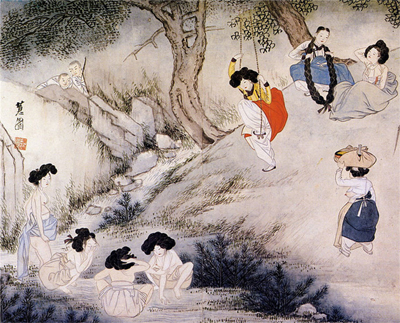
In Korea, it literally means ‘cold food.’ In the modern version of Hansik, people welcome the warm weather thawing the frozen lands. On this day, rites to worship ancestors are observed early in the morning, and the family visits their ancestors’ tombs to tidy up. At this time of year, the sky becomes clearer and buds sprout in the field. Farmers sow various seeds and supply water to their rice paddies. The custom of eating cold food on this day is believed to be originated from a Chinese legend, but recently this custom has disappeared.
Source: Wikipedia

